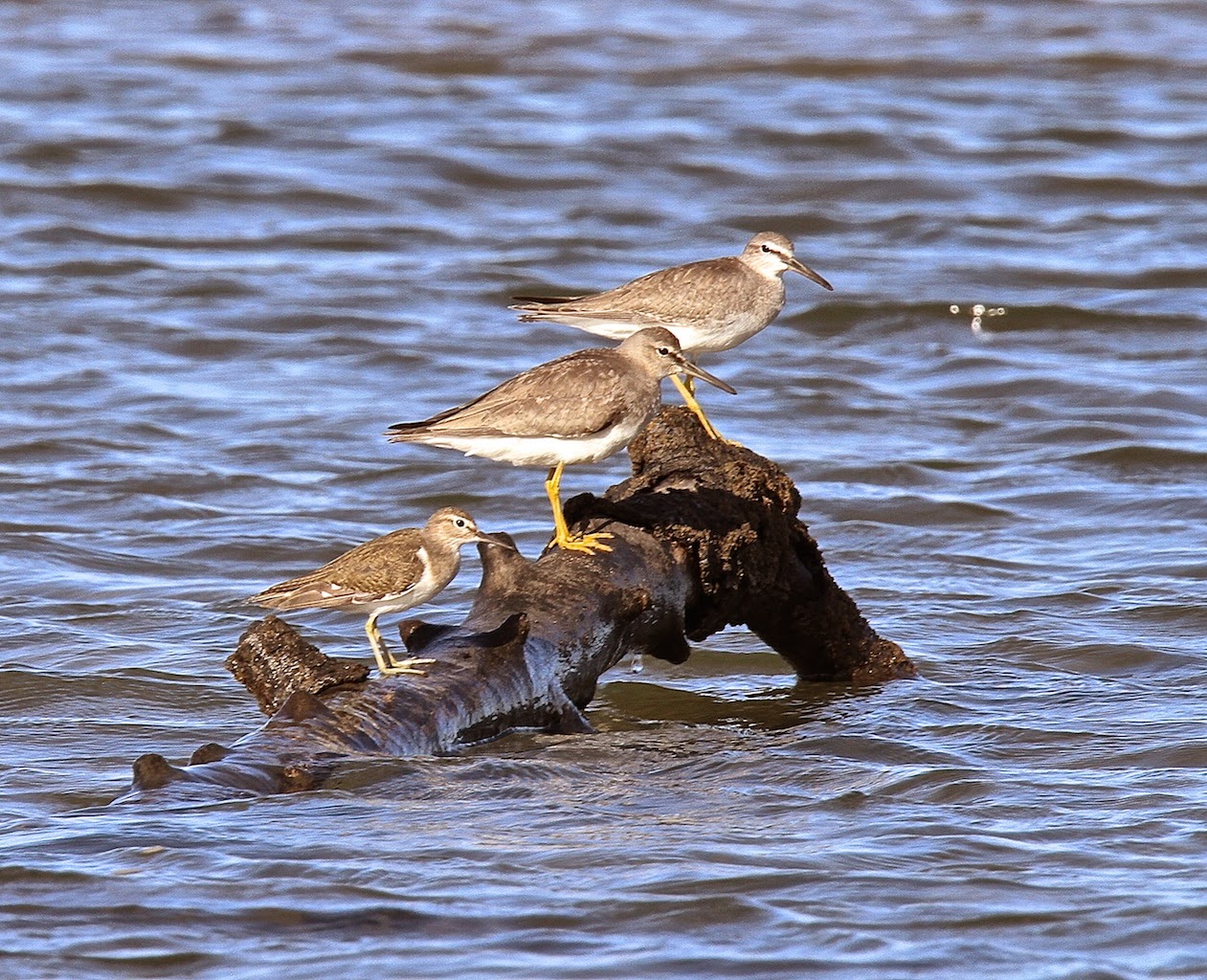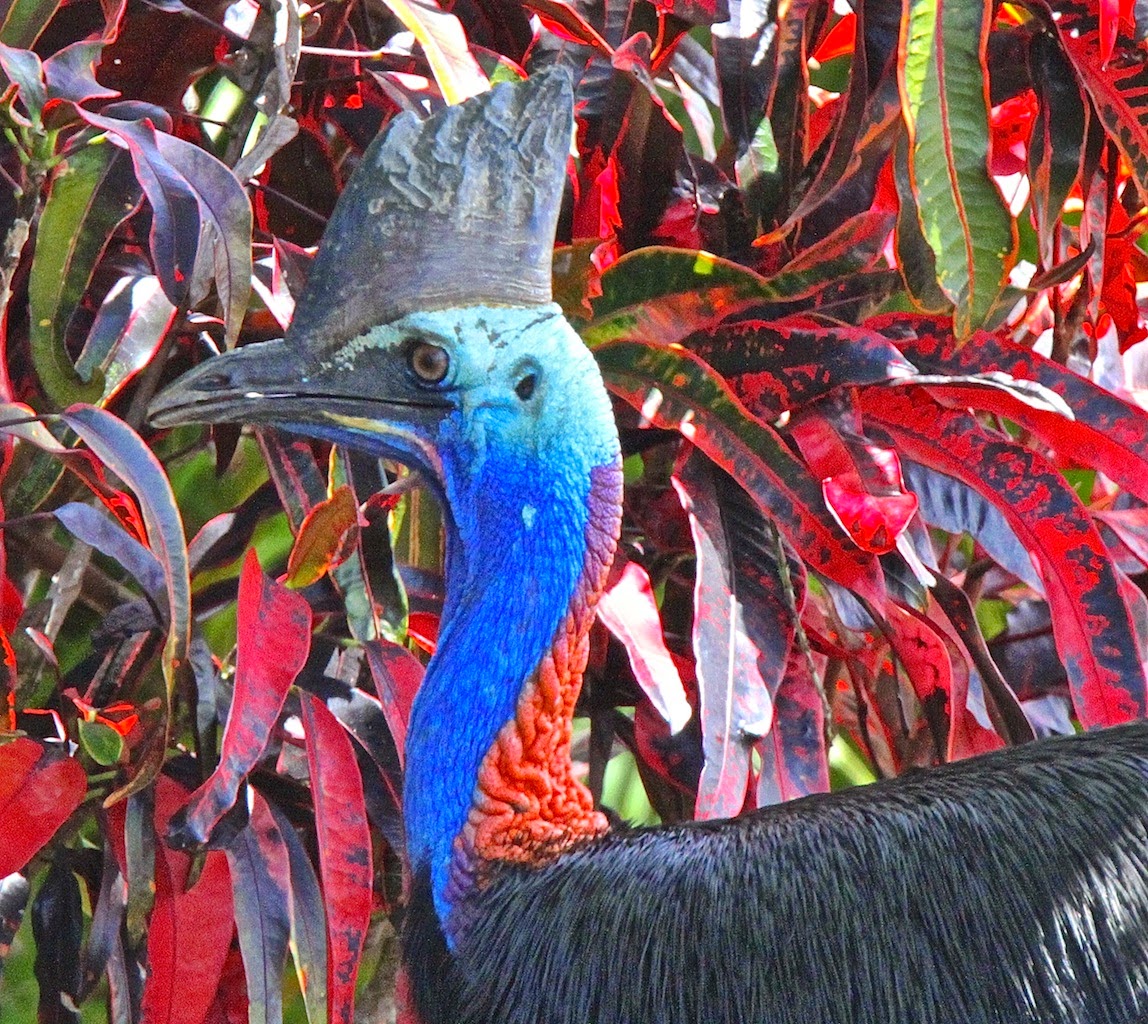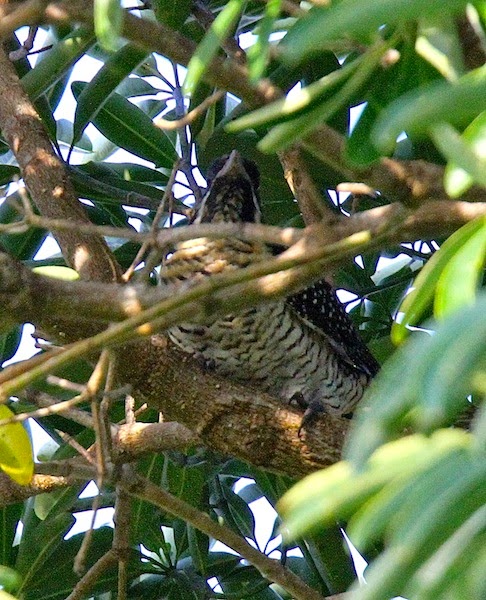After three months with little rainfall the drought has broken and good rains have been recorded across most of northern Australia. Here at Coquette Point we are notching rainfall of 100 mm for the week.
 The first sign of a change in the weather came on Monday afternoon when cumulus clouds started to build on the horizon, a rainbow formed off Flying Fish Point, the first for the season, and it was quickly replaced by a double rainbow spread in a glorious coloured arch across the mouth of the Johnstone River. It was a rainbow bridge linking Flying Fish Point to Coquette Point. I was walking on the beach at the time but only had the 600 mm lens and the double rainbow was so close I could not photograph it, I needed the wide angle lens, isn't it always the way.
The first sign of a change in the weather came on Monday afternoon when cumulus clouds started to build on the horizon, a rainbow formed off Flying Fish Point, the first for the season, and it was quickly replaced by a double rainbow spread in a glorious coloured arch across the mouth of the Johnstone River. It was a rainbow bridge linking Flying Fish Point to Coquette Point. I was walking on the beach at the time but only had the 600 mm lens and the double rainbow was so close I could not photograph it, I needed the wide angle lens, isn't it always the way. |
| The first rain squall of the season moved up the Johnstone River |

Looking out to sea I saw a dolphin, snub nosed I think, surface then dive followed by a spout of mist expelled through the dolphin's blowhole. Suddenly there was an explosion of fish as the dolphin chased a school of large sea mullet across the mouth of the river.
For weeks now the surface of the Johnstone River has been alive with the movement of fish jumping or visibly stirring in the clear waters below. The lack of sediment-laden-runoff has invited a massive influx of fish into the river and by the looks of the fingerlings alongside the river banks the fish have had a very successful breeding season. The cost of agricultural runoff to the marine environment can be easily measured when the runoff stops. It has only been three months and the fish populations have bounced back. Nature is resilient but for how long?
 |
| Unfortunately I did not capture the dolphin which was chasing these fish. |
While we are enjoying the rain the extreme drought continues in the West and always a measure of inland drought is the presence of large numbers of pelicans on the coast. The photo above is part of a pod of over 50 pelicans at the mouth of Liverpool Creek. Below, more of the pod with two little terns in the foreground on the sand bar. In the distance are the North Barnard Islands National Park.
It all looked so perfect, a natural haven, on the shores of the World Heritage Great Barrier Reef adjoining the Kurrimine Beach National Park, part of the World Heritage Wet Tropics. The World Heritage Listing for this area states."The beach area around the mouth of Liverpool Creek is a known nesting site for endangered little terns Stemula albifrons which are highly susceptible to predation from feral pigs and disturbance by vehicle."
 The only sign to inform anyone venturing into this area is propped up against the mangroves and almost hidden from view. It looks as if National Park, EHP or Wet Tropics authorities don't care. No signs at all to warn anyone that this area, between November and March is a breeding rookery for the endangered little tern. No sign what so ever to say that this important area of high biodiversity is part of the World Heritage Wet Tropics.
The only sign to inform anyone venturing into this area is propped up against the mangroves and almost hidden from view. It looks as if National Park, EHP or Wet Tropics authorities don't care. No signs at all to warn anyone that this area, between November and March is a breeding rookery for the endangered little tern. No sign what so ever to say that this important area of high biodiversity is part of the World Heritage Wet Tropics.If nobody knows, is it any wonder that people are driving Quad bikes all over the little tern rookery, smashing the eggs and squashing the chicks?

 So what can be done? It is only one or two people who are causing the problem and possibly they do not know what they are doing. The guilty parties are without doubt the people we entrust with the duty to protect the natural integrity of these significant areas. Vehicles should be prohibited from this area and the area should only be accessible for low key nature based experiences.
So what can be done? It is only one or two people who are causing the problem and possibly they do not know what they are doing. The guilty parties are without doubt the people we entrust with the duty to protect the natural integrity of these significant areas. Vehicles should be prohibited from this area and the area should only be accessible for low key nature based experiences.
Please join me and write asking for action to protect foreshore breeding sites for migratory and resident shorebirds, write to:-
CEO, Cassowary Coast Regional Council. enquiries@cassowarycoast.qld.gov.au
Minister for National Parks, The Hon Steven Dickson MP. email Buderim@parliament.qld.gov.au
Minister for protection of flora and fauna, The Hon Andrew Powell MP. email environment@ministerial.qld.gov.au
Threatened Species Commissioner, Mr Gregory Andrews, Department of the Environment,
GPO box 787, Canberra ACT 2601.
Federal Minister for the Environment, The Hon Greg Hunt MP greg.hunt.mp@environment.gov.au
GPO box 787, Canberra ACT 2601.
Federal Minister for the Environment, The Hon Greg Hunt MP greg.hunt.mp@environment.gov.au
 At Coquette Point two new common greenshanks have arrived. I found one bird fishing in a pool near the rocks and the other out on the front beach fishing with grey tailed tattler.
At Coquette Point two new common greenshanks have arrived. I found one bird fishing in a pool near the rocks and the other out on the front beach fishing with grey tailed tattler.Only a few Pacific golden plovers remain feeding at Coquette Point and most of the flock of red-necked stints has moved on however there seems to be increased numbers of lesser and greater sand plovers. The populations of waders at Coquette Point is dynamic.


White-bellied sea eagle has two newly fledged young. I found her watching them as they flew on the updrafts along the Moresby Range on the ocean front.



On my way back from the walk I found two grey-tailed tattlers and a common sandpiper standing on a log in the estuary. It was very strange to see common sandpiper so still and away from his feeding grounds, normally he is bobbing his bottom as he feeds on the sand flats, perhaps something had chased the three and they moved to the log-raft for safety.
In the mangroves nearby striated bitten was feeding and he was only interested in finding dinner, nothing was interrupting his concentration.
I saw another two year old cassowary subadult this week and believe it is Hagar's chick from 2012. The left wattle has a chunk out of it and so this bird will be easy to identify in future. His neck and face colours are already strong but he is very small for his age and was enjoying the Panama berries on the tree outside Drahm's house. He was rather timid and it appears he has been deep inside the Moresby Range National Park for the last twelve months. No doubt the lack of rain has brought him out. It is good to see that the two chicks from 2012 are doing well and moving widely within their territory.
When the first rain squall finished I went for a walk to photograph the wet leaves in the rainforest and I found Jessie, totally drenched sitting in the middle of the walking track and looking very happy with the rain.
There's not a lot of fruit on the forest floor at the moment and I watched Ky watching Snout as he ate palm seed. As soon as Snout finished Ky moved in and ate the rest of the seed.

Cassowary Queenie continues to cross Ninds Creek using the footbridge. Almost daily I receive reports of her walking to and fro across the bridge. Everyone is astounded when they see her turn to cross on the footbridge as if she knows instinctively that it is the safest way to cross.
Nellie and Henry Epong took these photos of Queenie this week, thank you Nellie and Henry for sharing them with us.
Taggs reports that Rainbow is still with Hagar and he sees them regularly, Taggs has promised some photos of them. Thanks Taggs will keep you to the promise.
Diana O reports, "Saw the two new young chicks again this week, the Dad is very good at herding them across the road. Communication between drivers is good too with drivers warning if they are on the road. "Thank you Diana it's four C's for the Coquette Point Community Caring for Cassowaries.
Diana O reports, "Saw the two new young chicks again this week, the Dad is very good at herding them across the road. Communication between drivers is good too with drivers warning if they are on the road. "Thank you Diana it's four C's for the Coquette Point Community Caring for Cassowaries.

The rain instantly changed the soundscape of the rainforest area. White-lipped tree frog is back to his old tricks and in every downpipe an army of frogs has again formed the 'frog organ' and is playing relentlessly at top volume.
Litoria jungguy, northern Stony Creek Frog, has also become active and his softly murmured trill is a constant underlining sound around the ponds.
Below this may or may not be the same freckled individual I came across a few weeks ago.

 The jumping spiders are also on the hop and I found one of the largest male green jumping spiders, Mopsus mormon, I have ever seen this week. He was hunting on a small shrub but I could not see his victim.
The jumping spiders are also on the hop and I found one of the largest male green jumping spiders, Mopsus mormon, I have ever seen this week. He was hunting on a small shrub but I could not see his victim. I photographed him as he moved across the plant, then I looked into his eyes. This male is the largest jumping spider found in Australia. Most jumping spiders are not aggressive when handled however, green jumping spider can give a painful bite, note the fang poised for action in the photo below.
I photographed him as he moved across the plant, then I looked into his eyes. This male is the largest jumping spider found in Australia. Most jumping spiders are not aggressive when handled however, green jumping spider can give a painful bite, note the fang poised for action in the photo below.
The jumping spider on the left Euryattus wallace is putting on a defence display on my thumb.
Thank you Robert for identifying her she's a dark beauty. Robert told me the male performs complicated signalling displays.
Thank you Robert for identifying her she's a dark beauty. Robert told me the male performs complicated signalling displays.
Not to be outdone the very colourful Cosmophasis micarioides was out and about all over the place enjoying the multitudes of insects hatching in the hot humid air.
Stick insects have hatched in large numbers but kookaburra and butcher bird are keeping them under control.


On a guava tree in the nursery Gloria found an unusual caterpillar it is 11 cm long and growing. In the sun its spines are iridescent blue. I sent a photo to Jack at the Insect Farm and he could not make an ID. So my spiny beast is encased in a mosquito net and I must wait to see what type of moth eventually hatches out.
When you look into his eyes he looks like an unhappy spiny pomeranian dog.
If you look the world is full of amazing creatures.
The happiest sound of all this week has come from the yellow oriole. From high in the canopy his bubbly mating call carries across the forests and not even butcher bird's melody can compete with yellow oriole's repertoire during the mating season.
A couple of date claimers this week. Mandubarra Turtle Rehibilation Centre will be releasing two turtle at Kurrimine Beach next Saturday 6 December. Meet at Lyons Park 10am.
Friends of Ninney Rise will be holding a 'Garden Ramble' at Ninney Rise tomorrow Sunday 30 November starting at 3pm.
Cheers for this week,
Yvonne






























































